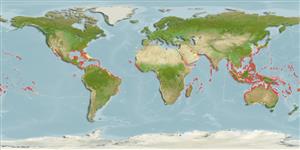Common names from other countries
>
Beloniformes (Needle fishes) >
Exocoetidae (Flyingfishes)
Etymology: Parexocoetus: Greek, para in the side of + Greek, exos = outside + Greek, koite = hole (Ref. 45335).
More on author: Richardson.
Environment: milieu / climate zone / depth range / distribution range
นิเวศวิทยา
เกี่ยวกับทะเล,น้ำเค็ม; สัตว์น้ำที่อาศัยและอพยพภายในทะเลเท่านั้น (Ref. 51243); ระดับความลึก 0 - 20 m. Subtropical; 37°N - 35°S, 34°E -
Indo-Pacific: widespread from East Africa, including the Red Sea (Ref. 26165) to southern Japan, Hawaii, the Marquesas, and Queensland (Australia); separate population in the eastern tropical Pacific (Bay of Panama). Western Atlantic: northeastern Florida, USA and the Bahamas to Brazil (Ref. 7251); common in Caribbean Sea and Lesser Antilles area; less common in the Gulf of Mexico, the Gulf Stream and the western Sargasso Sea (Ref. 3720). Eastern Atlantic: Guinea to Angola (Ref. 4498).
Length at first maturity / ขนาด / น้ำหนัก / Age
Maturity: Lm 12.0, range 11 - 13 cm
Max length : 20.0 cm TL เพศผู้/กระเทย; (Ref. 5217); common length : 16.0 cm TL เพศผู้/กระเทย; (Ref. 5217)
เงี่ยงครีบหลัง (รวม) : 0; ก้านครีบอ่อนที่หาง (รวม) : 12 - 14; เงี่ยงครีบก้น: 0; ก้านครีบอ่อนที่ก้น: 12 - 14. Body iridescent greenish blue dorsally, silvery white ventrally; dorsal black except for base and posterior rays which are pale; pelvic fins greyish, other fins transparent (Ref. 2797).
Occurs in coastal waters (Ref. 9300), rare in the open ocean (Ref. 9839). Capable of leaping out of the water and gliding for considerable distances above the surface. 3-4 individuals aggregate during breeding (Ref. 47825). Carnivorous (Ref. 9137). Not important as food fish, but occasionally taken by fisheries.
During breeding, a spawning aggregation composed at least of 3-4 individuals, probably 2-3 males to 1 female, were observed jumping and flying over the water surface, exuding ripe eggs and sperm in the process.
Spawning on surface substrate (e.g. flotsam) when present is the usual reproductive mode but other modes may be employed if this substrate is not available. The fertilised eggs may remain suspended in the water surface during its development with the help of the small filaments on the egg surface and the adhesive filaments holding the egg mass together, by increasing the surface to volume ratio of the eggs, which aids in propping the eggs up in the water column. The eggs may also be suspended upon current or become benthic.
Parin, N.V., 1996. On the species composition of flying fishes (Exocoetidae) in the West-Central part of tropical Pacific. J. Ichthyol. 36(5):357-364. (Ref. 27313)
IUCN Red List Status (Ref. 130435)
CITES (Ref. 128078)
Not Evaluated
Threat to humans
Harmless
Human uses
การประมง: มีการค้าเพียงเล็กน้อย
เครื่องมือ
Special reports
Download XML
แหล่งที่มาจากอินเตอร์เน็ต
Estimates based on models
Preferred temperature (Ref.
115969): 23.3 - 29.2, mean 27.8 (based on 4764 cells).
Phylogenetic diversity index (Ref.
82804): PD
50 = 0.6250 [Uniqueness, from 0.5 = low to 2.0 = high].
Bayesian length-weight: a=0.00646 (0.00292 - 0.01429), b=3.04 (2.84 - 3.24), in cm Total Length, based on LWR estimates for this (Sub)family-body shape (Ref.
93245).
ระดับชั้นอาหาร (Ref.
69278): 3.4 ±0.45 se; based on food items.
ความสามารถในการกลับคืนสู่ปกติ (Ref.
120179): ความสูง, เวลาต่ำสุดที่จะทำให้ประชากรเพิ่มขึ้นเป็น 2 เท่าใช้เวลาน้อยกว่า 15 เดือน (Preliminary K or Fecundity.).
Fishing Vulnerability (Ref.
59153): Low vulnerability (10 of 100).
